Florenz, Uffizien, Raffael, Ehepaar Doni: Maddalena Strozzi (1489-1540) und der reiche 30jährige Tuchhändler Agnolo Doni (1474-1539) heiraten am 31. Januar 1504 in Florenz. Eine Woche zuvor ist die Entscheidung einer Kunstkommission zur Aufstellung von Michelangelos David gefallen. Die Skulptur soll nicht wie geplant weit oben im Chorbereich des Domes stehen, sondern vor dem Palazzo della Signoria. Dort ist sie seit 521 Jahren (heute als Kopie) noch immer zu bewundern.
Maddalena Strozzi (1489-1540) and the wealthy 30-year-old cloth merchant Agnolo Doni (1474-1539) were married on January 31, 1504, in Florence. A week earlier, the art commission had decided on the placement of Michelangelo’s David. The sculpture was not to be placed high up in the choir area of the cathedral as planned, but in front of the Palazzo della Signoria. It has been on display there for 521 years (today as a copy) and can still be admired today.
Kaufmann und Kunstfreund
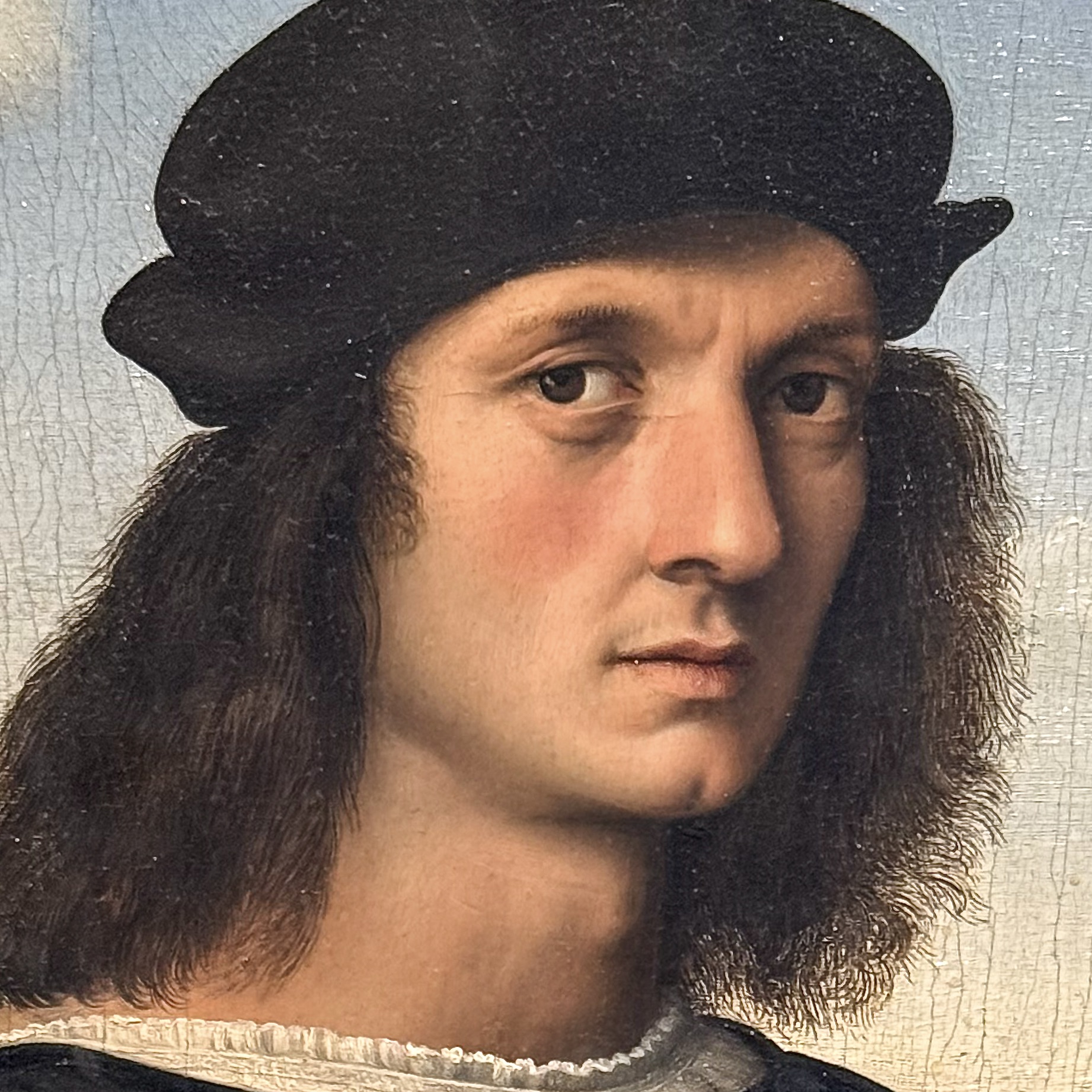
Der von Vasari als sehr sparsam, aber kunstliebend beschriebene Kaufmann gewinnt gewiss enorm an Ansehen, als er Michelangelo den Auftrag für den inzwischen weltbekannten Tondo Doni erteilt. An der Entscheidung ist vermutlich auch seine junge Ehefrau beteiligt, da ihr Wappen, aber nicht seines den Rahmen ziert.
Eine gleichfalls bedeutende Tat für die Geschichte der Kunst ist die Entschluss der Eheleute sich von Raffael (1483-1520) porträtieren zu lassen. Das Detail zeigt nicht nur die exzellente Malweise des jungen Künstlers, sondern einen eindrucksvollen Kopf mit sehr direktem, doch etwas verhaltenem Blick.
The merchant, described by Vasari as very thrifty but fond of art, certainly gained enormous prestige when he commissioned Michelangelo to paint the now world-famous Tondo Doni. His young wife was probably also involved in the decision, as her coat of arms, but not his, adorns the frame.
Another significant event in art history was the couple’s decision to have their portrait painted by Raphael (1483-1520). The detail not only shows the young artist’s excellent painting technique, but also an impressive head with a very direct, yet somewhat reserved gaze.
Florenz, Raffael, Ehepaar Doni: Entsprechung in Haltung und Hintergrund

Florenz, Raffael, Ehepaar Doni: In dem Doppelbildnis sitzen die Eheleute gegenläufig schräg zur Landschaft, sodass sie sich deutlich als zueinander gehörig präsentieren.
In the double portrait, the couple are seated diagonally opposite each other, facing away from the landscape, clearly presenting themselves as belonging together.
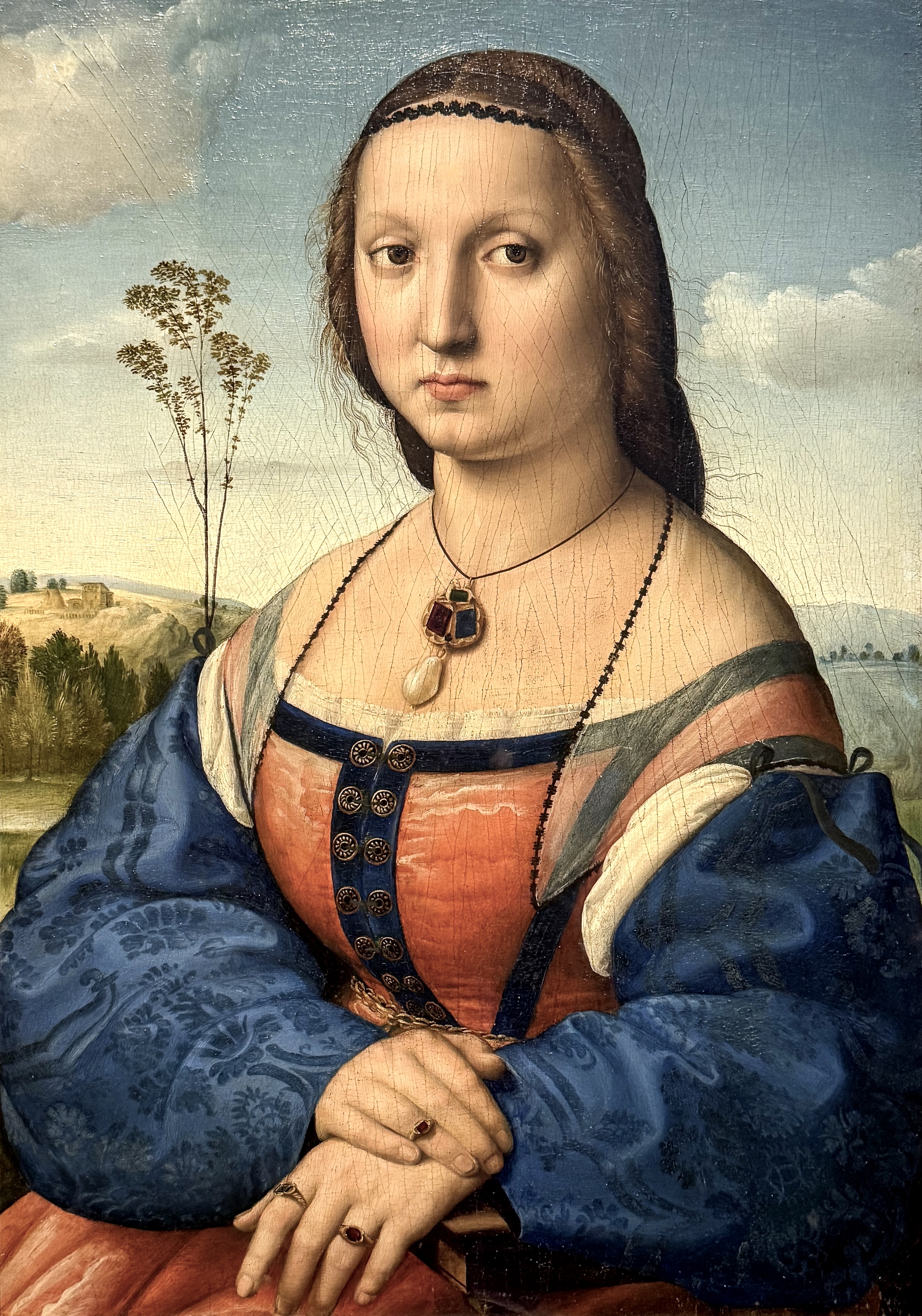
Raffael, Porträt Maddalena Strozzi, verh. Doni, 1504/06, Öl auf Lindenholz, 63,5 x 45 cm, Florenz, Uffizien
Das Bildnispaar ist zunächst ein Diptychon, das durch Scharniere verbunden ist, sodass auch die rückseitige Malerei betrachtet werden konnte. Die längst getrennten Tafeln sind seit 2018 nicht mehr im Palazzo Pitti, sondern frei im Raum neben dem Tondo Doni aufgestellt.
Raffael beginnt mit dem Porträt Maddalenas. Zunächst ist ein Innenraum mit Landschaftsausblick geplant (wie radiologische Aufnahmen verraten), dann aber stattdessen ein einheitlicher Landschaftsraum, der beide Bilder verbindet. Bei dem Frauenbildnis orientiert sich Raffael an Leonardos Mona Lisa. Sfumato und Rätselhaftigkeit sind aber nicht seine Sache. Er liebt klares Licht, Helligkeit, entsprechende Farben und genaueste Wiedergabe, sodass die Malerei und Gestalt eine unerhörte Präsenz ausstrahlen. Mit Ruhe und Ernst blickt die junge Frau zur Seite.
The pair of portraits is initially a diptych connected by hinges so that the painting on the reverse side could also be viewed. The panels, which have long been separated, have not been in the Palazzo Pitti since 2018, but are now freely displayed in the room next to the Tondo Doni.
Raphael begins with the portrait of Maddalena. Initially, an interior with a view of the landscape is planned (as revealed by radiological images), but then instead a uniform landscape space that connects both paintings. Raphael based his portrait of the woman on Leonardo’s Mona Lisa. However, sfumato and mystery are not his thing. He loves clear light, brightness, appropriate colors, and the most accurate reproduction, so that the painting and figure radiate an unprecedented presence. The young woman gazes to the side with calm and seriousness.
Ein vornehmer Bürger mit beringter Hand
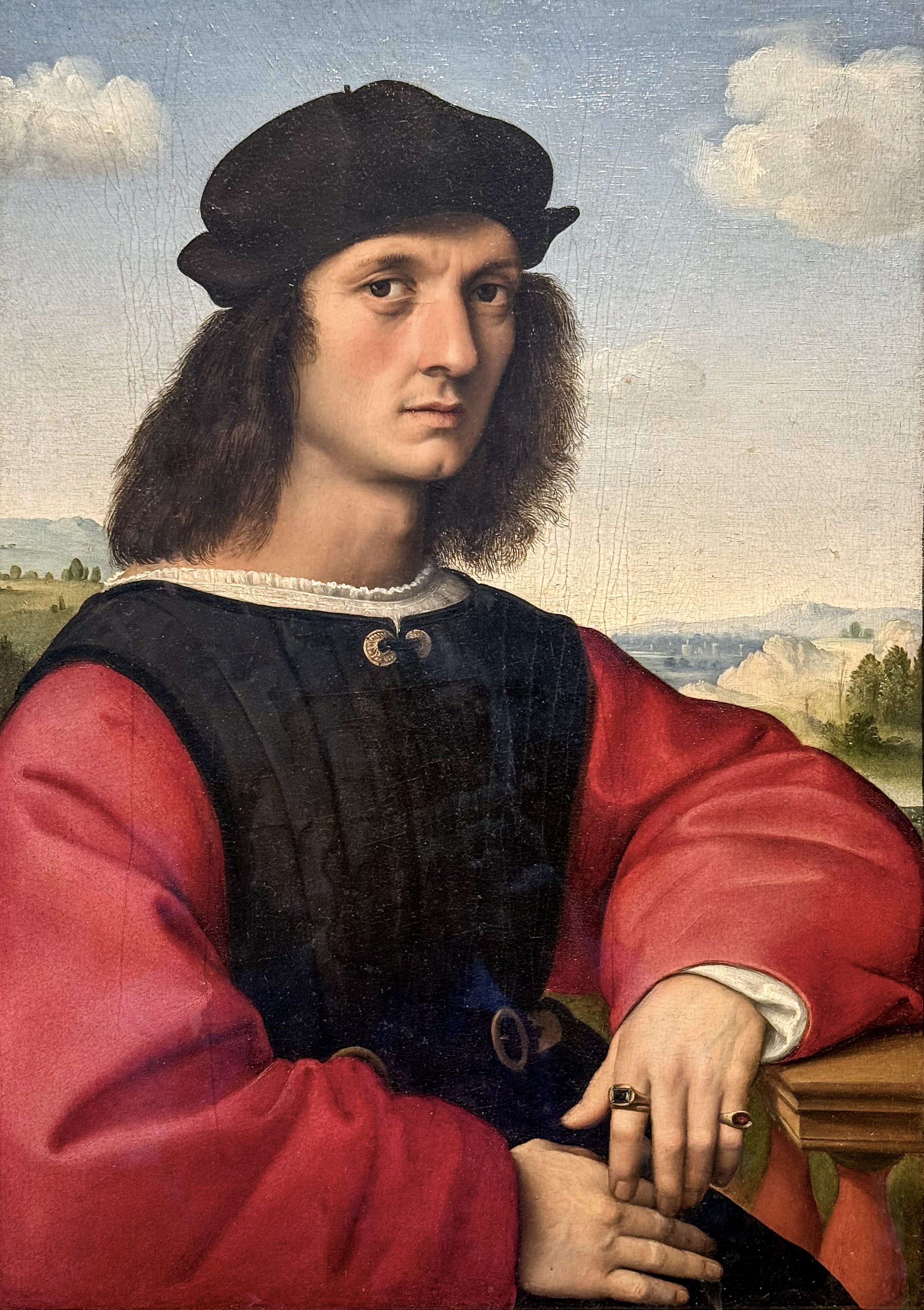
Raffael, Porträt Agnolo Doni, 1504/06, Öl auf Lindenholz, 63 x 45 cm, Florenz, Uffizien
Der Ehemann, gleichfalls eine elegante Erscheinung, blickt mit großer Ruhe auf den Betrachter. Beide Eheleute sind selbstbewusste und würdige Repräsentanten der Oberschicht ihrer Stadt.
Ob es zur Ausführung der Gemälde in direktem Zusammenhang mit der Hochzeit kommt, ist fraglich. Maddalena wirkt doch wesentlich älter als 15jährig. Auch ist beiden zunächst familiärer Segen versagt. Es sterben mehrere ihrer Kinder, womit die Rückseite in Verbindung stehen könnte. Erst 1507 überlebt eines.
The husband, also an elegant figure, gazes calmly at the viewer. Both spouses are self-confident and dignified representatives of their city’s upper class.
It is questionable whether the painting was directly related to the wedding. Maddalena appears to be much older than 15. Furthermore, the couple was initially denied the blessing of children. Several of their children died, which could be related to the reverse side. Only one survived, in 1507.
Florenz, Raffael, Ehepaar Doni: einmalige Rückseiten nach Ovid

Rückseite der Tafel des Ehemannes: monochrom bemalt von einem namenlosen, nicht sehr bedeutenden Zeitgenossen, dem man nach seinem Hauptwerk Meister von Serumido in der Kirche San Pier Gattolino benannt hat. Der Schattenstreifen oben rührt von dem freistehenden Bildkasten her.
Dargestellt sind auf den beiden Rückseiten Hauptszenen der Geschichte von Deukalion und Pyrra nach Ovids Metamorphosen I, 315 ff. Die Runde der Götter ist mit der ruchlosen Menschheit so unzufrieden, dass sie eine Sintflut mit Sturm auslöst. Alle Menschen ertrinken bis auf ein ganz altes Paar.
Back of the panel by Agnolo Doni: painted in monochrome by an anonymous, not very significant contemporary, who was named after his main work, “Master of Serumido,” in the church of San Pier Gattolino. The shadow strip at the top comes from the freestanding picture frame.
Depicted on both backs are main scenes from the story of Deucalion and Pyrra according to Ovid’s Metamorphoses I, 315 ff. The gods are so dissatisfied with humanity that they unleash a flood with a storm. All humans drown except for one very old couple.
Steine werden zu Menschen
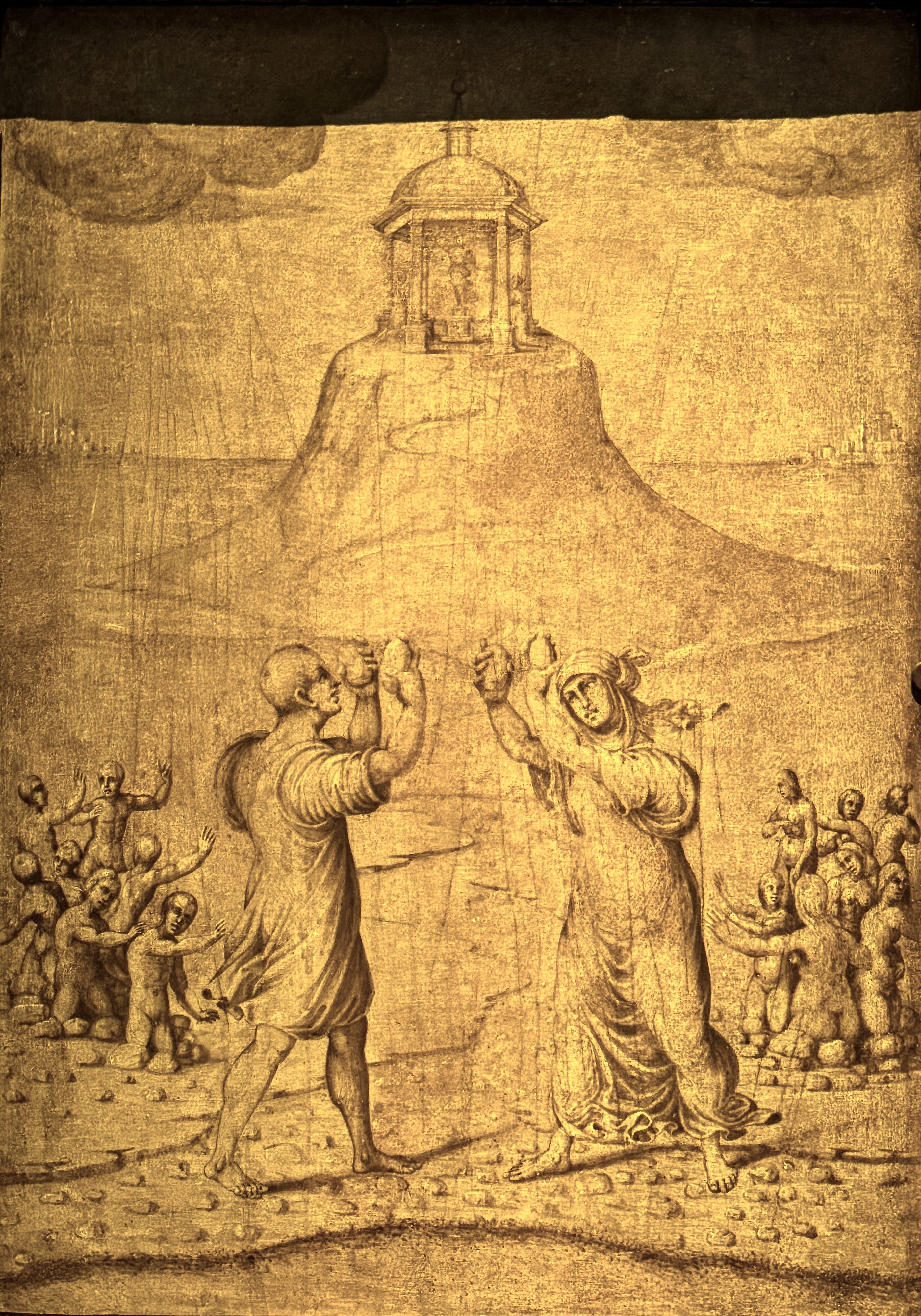
Rückseite der Tafel von Maddalena Doni
Die Sintflut ist zu Ende, die Wassermassen gehen zurück. Nur die lauteren alten Eheleute Deukalion und Pyrra haben überlebt. Nach der Befragung des Orakels im kleinen Tempel auf der Bergkuppe werfen sie Steine hinter sich. Die von Pyrrha verwandeln sich in Frauen und die von Deucalion in Männer.
Im Kontext von Raffaels Bilderpaar darf dieser Mythos als Hoffnung auf Kindersegen verstanden werden.
Back of the panel by Maddalena Doni.
The flood is over, the waters are receding. Only the virtuous elderly couple Deucalion and Pyrrha have survived. After consulting the oracle in the small temple on the hilltop, they throw stones behind them. Those thrown by Pyrrha turn into women, and those thrown by Deucalion turn into men.
In the context of Raphael’s pair of paintings, this myth can be understood as a hope for the blessing of children.

Raffael, Selbstbildnis, 1504/06, Öl auf Holz, 47,3 x 34,8 cm, Florenz, Uffizien
Dieser etwas verträumt und scheu wirkende junge Mann mit Anfang zwanzig steht gleichrangig neben Leonardo und Michelangelo. Entstanden in der Zeit der Doni-Porträts.
This somewhat dreamy and shy-looking young man in his early twenties stands on equal footing with Leonardo and Michelangelo. Created during the period of the Doni portraits.
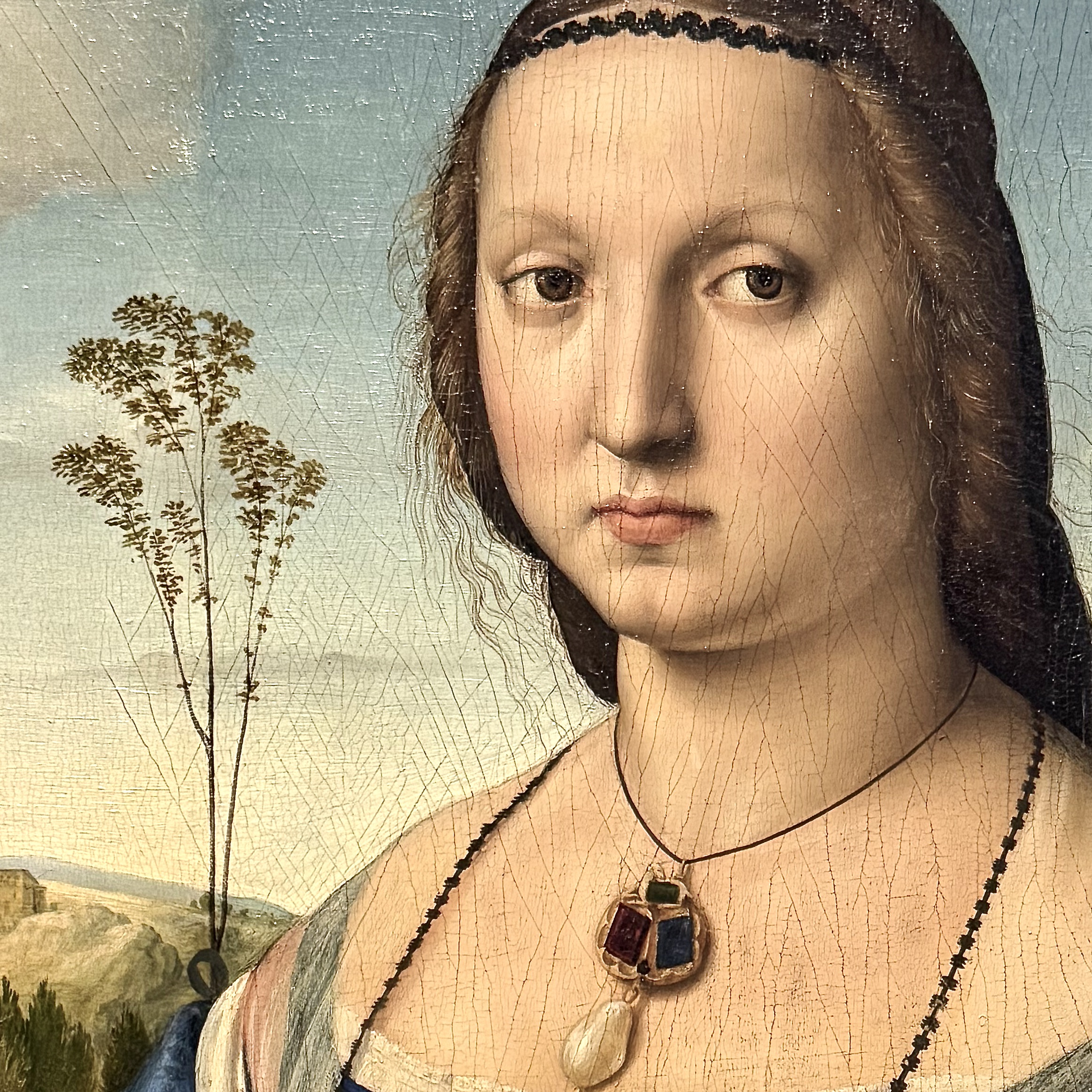
Danke lieber Christian für die Portraits von Raffael! Die Gesichter sprechen einen direkt an, wie alte Bekannte.